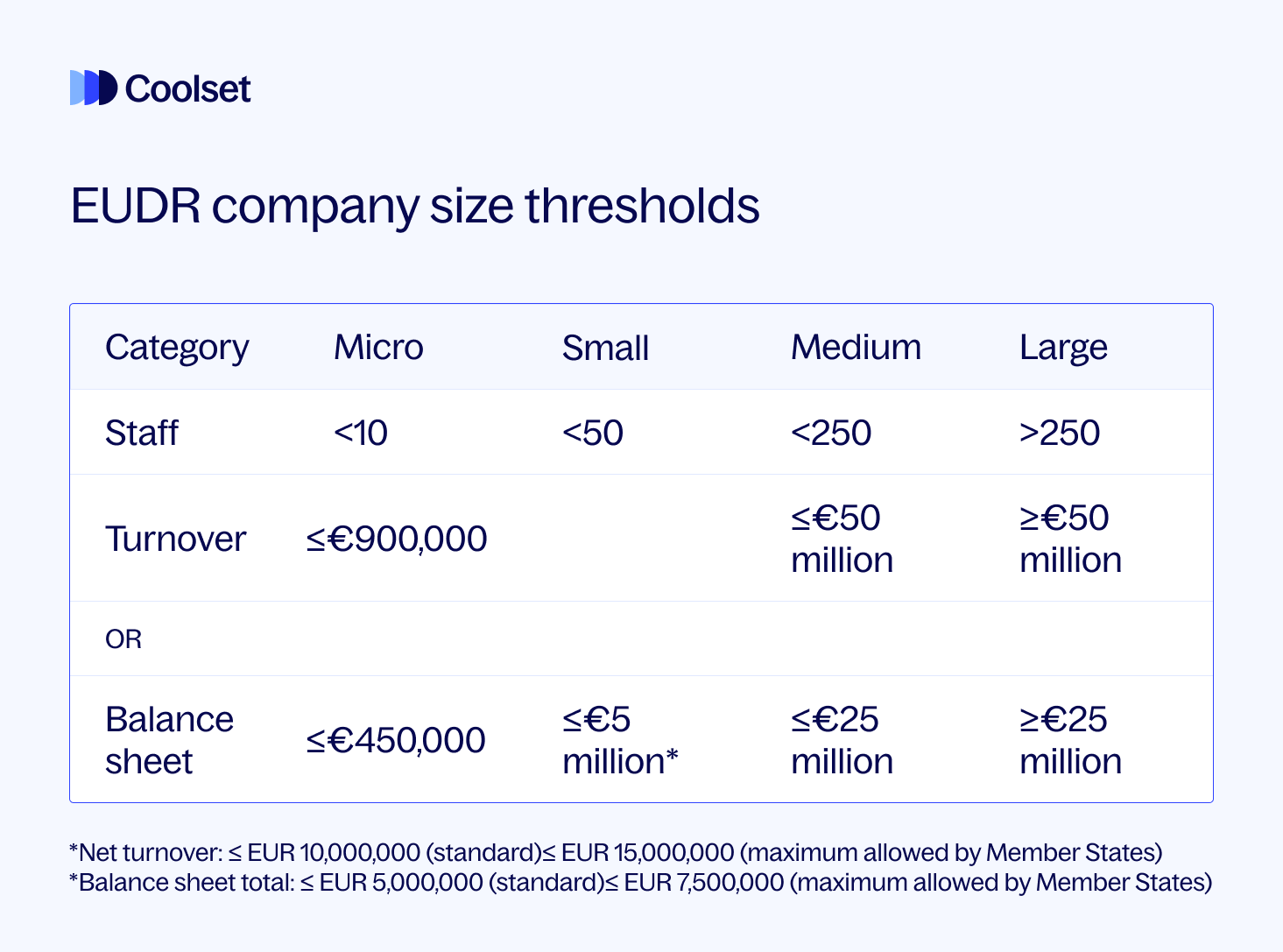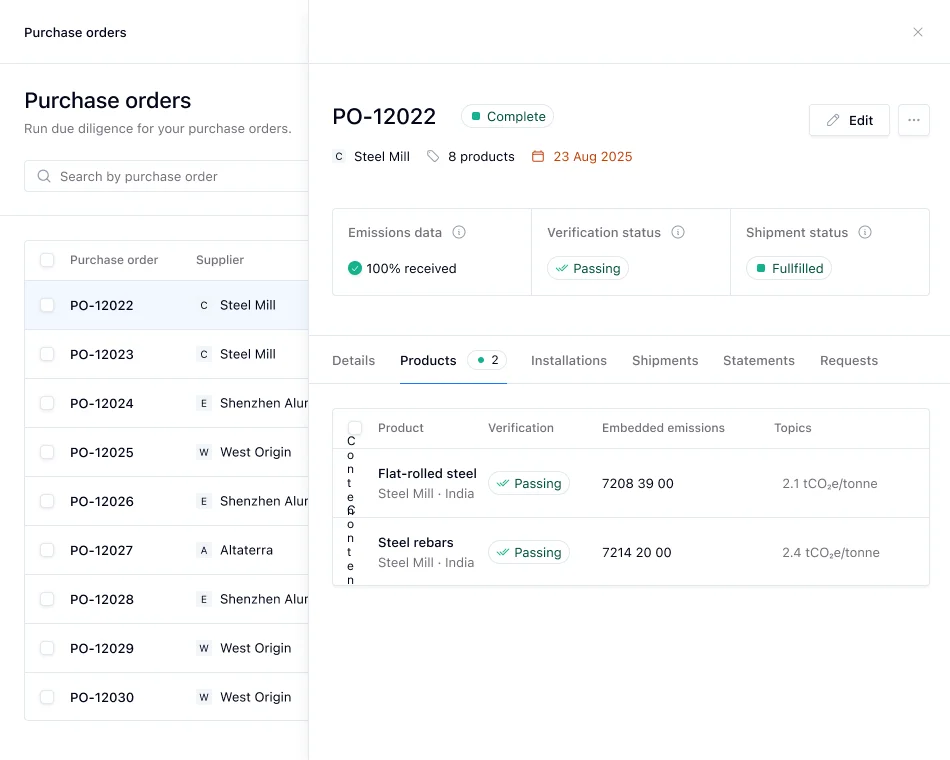Disclaimer: Latest EUDR developments
On 21 October, the European Commission proposed targeted changes to the EU Deforestation Regulation (EUDR). These adjustments aim to make the rollout smoother without changing the regulation’s overall goals.
Key points from the proposal:
We're closely monitoring the development and will update our content accordingly. In the meantime, read the full explainer here.
Latest update: November, 3, 10:45 CET
After weeks of speculation about potential delays, the European Commission has now proposed official changes to the EU Deforestation Regulation (EUDR). The goal is to make the rollout smoother without changing its core objectives.
Under the latest proposal from 21 October 2025, the main compliance deadline for large and medium operators remains 30 December 2025, while small and micro primary producers (such as farmers and foresters in low-risk countries) may receive extra time - until 30 December 2026. The Commission also plans a transition period from January to June 2026, during which authorities will focus on support instead of penalties.
In this article, we explain what’s changed, what remains the same, and what compliance teams should do now to stay aligned with the evolving EUDR timeline.
{{custom-cta}}
The EU Deforestation Regulation (EUDR) becomes legally binding from 30 December 2025 for all operators and traders. However, if The European Commission's latest proposal from 21 October 2025 is accepted and adopted, small and micro operators will gain an additional six months, until 30 December 2026, to comply.
Below is a summary of The European Commission's newly proposed EUDR timeline:

The October 2025 proposal still requires European Parliament and Council approval. However, it outlines the clearest roadmap to date.
The EUDR timeline has developed over several stages. In 2024, the original enforcement deadline was postponed from December 2024 to December 2025. This was followed by renewed uncertainty in September 2025 after Commissioner Roswall's letter proposed a one-year further delay. More recently, on 21 October 2025, The European Commission's latest proposal maintains the 2025 deadline for large and medium operators, while suggesting phased enforcement and a later deadline for small and micro operators. The proposal is now under review by Parliament and Council.
Here’s the detailed timeline of EUDR changes, accepted and proposed delays, starting with the most recent updates:
In a shift from the tone from Commissioner Roswall’s letter, The European Commission's latest proposal maintains the original timeline for most large and medium-sized operators, suggesting to:
For a condensed summary of the October proposal, download our EUDR latest proposal cheat sheet.
Following Commissioner Roswall's letter, EU debate intensified. Several Member States backed a delay, citing competitiveness and administrative burden. The European People’s Party supported postponement as a way to correct regulatory flaws and protect SMEs. In contrast, the Socialists & Democrats criticized the move, calling the delay a concession to lobbying pressure that risks weakening enforcement. Meanwhile, in a separate letter from major companies including Nestlé, Mars Wrigley and Ferrero, they urged the European Commission not to delay the EUDR and reaffirmed their commitment to the December 2025 deadline.
In a letter to the European Parliament and the Council, Commissioner Jessika Roswall recommended postponing EUDR enforcement until December 2026. The proposal cited delays in the EU’s TRACES IT system and uneven readiness across Member States as key reasons for deferring the enforcement timeline.The letter was non-binding and intended to ease growing political pressure around the regulation’s rollout.
In 2024, the enforcement timeline for the EUDR was moved from December 2024 to December 2025, citing system and enforcement readiness concerns.
{{product-tour-injectable}}
The EUDR deadline or deadlines, only change after the European Union goes through its full legislative process. Firstly, the proposal must be passed by the European Parliament and the Council, and formal adoption and publication in the Official Journal of the EU.
Political letters, like Commissioner Roswall's letter from 23 September 2025, express policy intentions or influence debate, but have no legal force. In contrast, legal amendments, such as the The Commission’s formal proposal published on 21 October 2025, initiate binding changes to EU regulations. However, only after approval by both Parliament and Council and publication in the Official Journal does a new timeline become legally enforceable.
For the EU Deforestation Regulation (EUDR), this means the 30 December 2025 deadline remains the only legally binding date until the amendment proposal is fully adopted and published.
The European Commission's latest proposal introduces role-specific adjustments to ease implementation without altering the core EUDR obligations.
Refer to our detailed breakdown of what the latest updates mean for different operator and trader roles and responsibilities:

1. No change for large and medium operators
Large and medium operators, with thresholds >50 employees and ≥€10mil turnover, must still collect supplier data, run risk assessments, and submit due diligence statements (DDS) via TRACES by 30 December 2025. These responsibilities apply whether sourcing from standard or low-risk countries.
2. New category: Micro and small primary operators
Farmers and small producers in low-risk countries who grow, harvest, or raise covered products themselves will no longer submit full DDS. Instead, they must file a one-time simplified declaration or provide data through a national or EU database. This generates a declaration identifier that follows the product across the supply chain.
3. Newly defined obligations for downstream operators
A new category, downstream operators, includes businesses that place products on the EU market whose raw materials have already been covered by a due diligence statement or declaration identifier. These operators no longer need to verify upstream due diligence or submit their own DDS.
4. Reduced burden for non-SME traders
Non-SME traders, those who buy and sell but don’t import directly, also no longer need to submit DDS or validate upstream compliance. Like downstream operators, they must register in TRACES and ensure reference numbers are passed along.
5. SME traders: no changes
Smaller traders continue to collect and retain DDS references but are not required to submit them.
These adjustments aim to make EUDR enforcement more practical and proportionate, avoiding disruption while maintaining accountability for large operators. However, the obligations for most importers remain the same, reinforcing the need to set up systems for supplier mapping, traceability and due diligence documentation. Coolset's EUDR solution can support companies managing supplier data, risk assessments, and TRACES submissions, particularly in preparing for compliance across different enforcement stages.

Large and medium operators are defined as companies above small and medium enterprise (SME) thresholds (typically >50 employees and >€10 million turnover) that place materials on the EU market, either through production or import, or export materials from the EU.
Example: A global cocoa importer sourcing from Côte d’Ivoire must geolocate farm plots, assess deforestation risk, and submit a DDS for every shipment placed on the EU market.
Micro and small primary operators refers to small producers or farmers who grow, harvest, or raise relevant products themselves and are established in low-risk countries as defined under the EU benchmarking system.
Example: A smallholder in Germany harvesting timber submits one declaration, which applies to all shipments going forward.
Downstream operators are now defined as companies that manufacture relevant products after they have been placed on the EU market and where all inputs are already covered by a DDS or simplified declaration.
Example: A chocolate manufacturer producing finished chocolate bars from cocoa that is already covered by a DDS, no need to submit a new DDS, only to track and transmit the existing references.
To be ready ahead of enforcement, companies typically begin by mapping supply chains, collecting supplier data, assessing risks, and building TRACES-compatible due diligence workflows.
6-step readiness playbook:
Clients use Coolset to centralize supplier data, manage version control, and automatically generate audit-ready due diligence statements (DDS) in TRACES-compatible formats.
All countries are currently classified as standard risk under the EUDR. The European Parliament rejected the Commission’s proposed benchmarking act, meaning no country currently benefits from any ‘low-risk’ shortcuts. As a result, all due diligence obligations apply equally, including geolocation, legality documentation, and risk assessments.
If the Commission's latest proposal is adopted, enforcement for large and medium operators would begin with a grace period from January to June 2026. During this time, competent authorities are expected to prioritise education, registration, and feedback, rather than immediate penalties. However, the legal obligations remain in force, and operators are still liable for compliance from the start of enforcement.
The grace period should be viewed as phased enforcement, not a delay. Companies should continue building due diligence workflows, collecting supplier data, and testing TRACES compatibility.
The European Commission's latest proposal now moves to the European Parliament and Council. The Commission aims for adoption before the end of 2025.
Coolset will continue monitoring all changes and update this article accordingly
The EUDR has not yet officially been delayed to 2026, the 30 December 2025 EUDR deadline remains legally binding for all operators and traders. The European Commission has proposed extending the deadline for small and micro operators to 30 December 2026, but this is not in force until formally adopted and published.
The grace period from January to June 2026 is part of the Commission’s proposed amendment. During this time, authorities would prioritise support and capacity building over penalties. However, compliance obligations, such as submitting DDS files and maintaining traceability, would still apply in full.
Only if the European Commission’s amendment is adopted, will small and micro operators have until 30 December 2026 to comply. Producers based in a low-risk country may also benefit from simplified reporting.
No. All imports are currently subject to standard risk under the EUDR. The EU Parliament rejected the Commission’s proposed benchmarking system, so no country currently benefits from a low-risk designation.
Companies should begin collecting geolocation, production, and legality data from suppliers, while preparing DDS workflows and testing TRACES compatibility. Early preparation can help reduce compliance risks and avoid last-minute implementation challenges.
Get practical with EUDR in 4 live, weekly sessions (Nov - Dec 2025)

If you need guiance, book a free EUDR demo with our team
